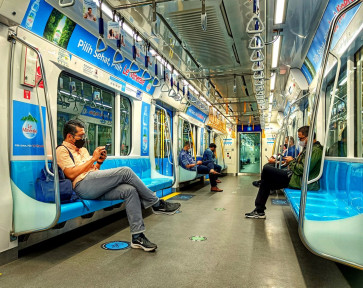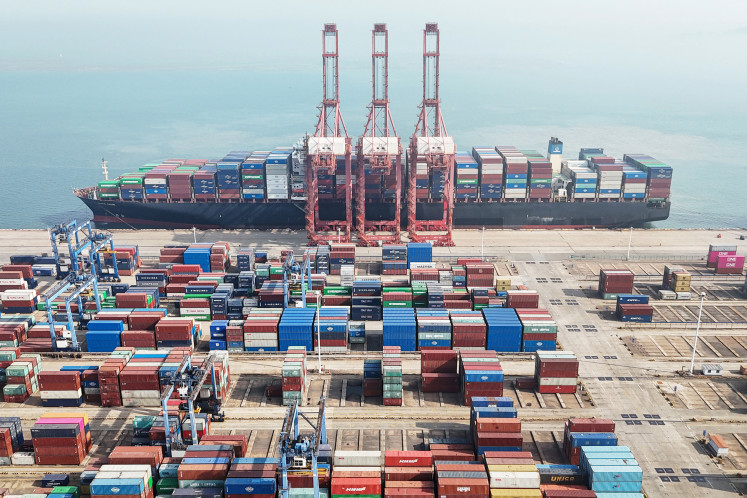Popular Reads
Top Results
Can't find what you're looking for?
View all search resultsPopular Reads
Top Results
Can't find what you're looking for?
View all search resultsReportage: Can Indonesia go global like India?
v: Visitors flock to Taj Mahal in Agra, one of the popular tourism spots in India
Change text size
Gift Premium Articles
to Anyone
v: Visitors flock to Taj Mahal in Agra, one of the popular tourism spots in India. (JP/Imanuddin Razak)
India, a South Asian country globally second to China in terms of population and seventh in terms of land territory, is still struggling to improve the prosperity of its people. Yet, it has thoroughly developed itself into a global IT (information technology) powerhouse. The Jakarta Post’s Imanuddin Razak was among a group of journalists from Indian Ocean Rim (IOR) member countries recently visiting India for a week-long comparative study, organized by the country’s Ministry of External Affairs.
It is an observable fact that India shares strong social, cultural and economic links with Indonesia.
Historical records show that relations between India and Indonesia began with the establishment of trading activities between sub-continental India and the Sriwijaya Kingdom (the capital of which was located in the area now part of South Sumatra) in the fourth century, continued with the migration of Indian people from southern India from then until the 11th century.
The Indian traders brought Hinduism and Hindu traditions to Indonesia, then only a collection of archipelagic states ruled by numerous kingdoms, with Sriwijaya and Majapahit among the largest.
Such trade and cultural relations continued with the arrival of the second phase of Indians, this time Muslim Indian traders from Gujarat and Kannur, Kerala. The migration of Indians continued into the mid 19th century in the wake of the industrial revolution in Europe until the years immediately following World War II.
Traces of such long continuing bilateral relations between India and Indonesia can be identified with the existing inscriptions in Jakarta and several places in Java explaining Hindu traditional activities organized by the ruling kings, or the presence of mosques in Jakarta which were built at the time of the arrival of Indian Muslims from
Gujarat.
Those are the historical aspects of our bilateral relations. Modern relations and the strong influence of Indian culture can be identified through the continuing significant presence of Indian movies (popularly known as Bollywood movies) here and the strong presence and influence of Indonesian dangdut music, which apparently has its roots in Indian music.
In the economic sector, our modern bilateral relations can be observed through our continuous trading relations. According to Indian government data, bilateral trade touched the historic US$20 billion mark in 2011, a huge increase from $3.93 billion in 2005.
Indonesia’s Central Statistics Agency (BPS) valued bilateral trade slightly lower at $17.65 billion–$13.33 billion worth of Indonesian exports and $4.32 billion of imports for 2011. In the first seven months of this year, trade between the two countries almost reached $10 billion. The trade value may top $25 billion by 2015.
In political affairs, both countries also share the same principles and policies. Born in the early post-World War II era, India and Indonesia are among the top three largest democracies in the world and their founding leaders — India’s first prime minister Jawaharlal Nehru and Indonesia’s first president Sukarno — were among the pioneers of the Non-Aligned Movement, the essence of which has been the key principle in each country’s foreign policy that is still maintained until this day.
In terms of development policy, both India and Indonesia have apparently gone down the same path. India started its long-term five-year development program in 1951, while Indonesia started its own similar long-term five-year development program in 1969. The only difference is that while India has managed to continue the program until now, Indonesia ended it in 1994.
The program here was reintroduced in 2005, under a 20-year program, and scheduled to be complete in 2025. But, it has so far yet to produce significant results as Indonesia has apparently been busy with the bigger tasks of conducting bureaucratic reforms and establishing good governance. Also, there is no guarantee that the program will continue when the current leadership ends its term in 2014.
Such a continuous development program has undoubtedly ensured steady, although gradual and perhaps even slow, progress in the achievement of India’s overall development, while Indonesia suffered considerably for over a decade after the 1998 reform and only managed to catch up with global development in the last few years.
Apart from the continuing development program, India’s excellent global achievement —particularly in its IT industry — cannot be separated from the fact that Indian people — although perhaps initially not by design — have since the fourth century decided to open up and explore opportunities across the globe.
Another significant factor is the availability and the affordability of manpower in India. In the words of A.S. Krishna, global head of corporate affairs and communication at Ranbaxy, India’s largest global pharmaceutical company: “Low cost of production is an advantage for Indian companies in going global.”
Amita Sarkar, senior director of the Confederation of Indian Industry (CII), meanwhile, highlighted India’s favorable demographics as its biggest advantage. “India is home to one of the youngest populations in the world,” she said, while citing a 2008 statistic provided by the United Nations (UN), which classifies India as one of the countries with the lowest percentage of population aged 65 and older.
Still, India’s global industrial achievement has not arrived at the expense of other sectors, including the most crucial for a populous nation like India — agriculture. Unlike Indonesia which has seen a decreasing number of people employed in its agriculture sector, India has more than enough manpower for the sector.
“Although a large number of jobs have been created in modern manufacturing and services such as IT, it is nowhere near enough to absorb all new entrants to the job market and the proportion of people employed in agriculture, on the other hand, also has not declined,” Bidisha Ganguly, CII’s head of economic research, said.
A lesson learned from India is that it is high time for Indonesian companies to go global despite the country’s lack of a record of exploring opportunities abroad. And it is true that it will be impossible for Indonesia to pursue such an ambition in all sectors.
Perhaps the development of global Indonesian industries and companies can be pursued by upgrading and improving the now stagnant Indonesian aircraft manufacturer PTDI, an area where Indonesia has enough experience and capable manpower to support the program; or increasing and maximizing the global presence of our popular national fabric batik; or intensifying global promotion of rendang, which was chosen in a 2011 online poll by CNN International as the number one dish of their “World’s 50 Most Delicious Foods” list.
We have the choice — and the opportunity. The question is whether we have the courage and the will to meet the challenge.










